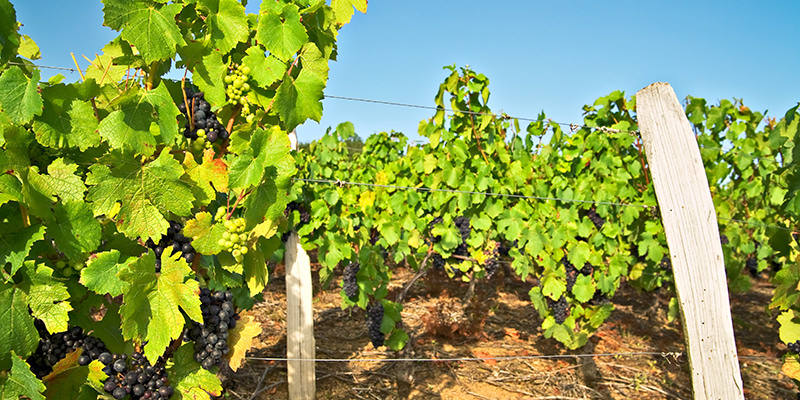Beaujolais has long been considered the quintessential Thanksgiving wine, thanks mostly to the young, just-barely-wine Beaujolais Nouveau and a lot of clever marketing in the 1970s. And while these light-bodied, low-tannin reds do pair well with turkey and all of its friends, doesn’t it seem odd that a French wine is the classic pairing for such an all-American holiday? Lucky for us, winemakers from across the U.S. are translating their love for Beaujolais into homegrown versions of the region’s signature grape, Gamay. We propose the anointing of a new Thanksgiving wine: Gamay from the good ol’ US of A.
It’s no coincidence that American plantings of Gamay have increased during the same time period that the underappreciated grape has gained popularity among sommeliers and wine lovers. Ironically, the same Beaujolais Nouveau that has tied the overall region so closely to the Thanksgiving holiday is also the primary reason for the Gamay grape’s poor reputation; to this day, many think of Beaujolais and the Gamay grape of only having the ability to produce thin, uninteresting wines. However, with a new generation of wine lovers who increasingly seek out terroir-driven wines, there has been a trend over the past ten to fifteen years to refocus on quality wines from Beaujolais, particularly those at the villages and cru levels.
For years, a grape called Napa Gamay was grown widely throughout California and incorrectly thought to be the same grape as Beaujolais’ Gamay Noir, until that was disproven in 1980. Rather, the first true, commercially-available Gamay was produced by Oregon’s Amity Vineyards in 1988, with California’s first real Gamay Noir not appearing until 2005 from Steve Edmunds of Edmunds St. John. Even today, domestic Gamay remains mostly an obscurity, with most bottles produced in limited batches from smaller-production wineries, adding to the low availability of the wines.
The challenge for American winemakers making Gamay is to retain acidity and minerality in the wines while managing ripeness and alcohol. Cool climates such as Oregon’s Willamette Valley, New York’s Finger Lakes, and the high-elevation Sierra Foothills tend to produce the best examples of American Gamay, but experimentation with new regions is continuing. Still skeptical of breaking the Beaujolais tradition? These five American Gamay wines rival top bottlings from their French counterparts and more than deserve a place at the table this Thanksgiving.
From California:
2014 Edmunds St. John ‘Bone-Jolly’ Gamay Noir, El Dorado County, CA: Nearly 10 years after producing California’s first true Gamay, Edmunds St. John’s ‘Bone-Jolly’ is still going strong. The key to the success of this wine is the elevation at which the grapes are planted; 3400 feet above sea level, the vineyard’s combination of plentiful sunshine and cooler temperatures allows grapes to ripen slowly. The result is this pretty, aromatic wine, with aromas of fresh violets and ripe berries. Just a touch of minerality and spice round things out, making this a fruity but balanced example of Gamay, and a true crowd pleaser.
2013 RPM Gamay Noir, El Dorado County, CA: The resurgence of Gamay is perhaps most strongly evidenced by the creation of RPM, a collaboration project dedicated exclusively to the production of Gamay from California’s Sierra Foothills. The duo between Arnot-Roberts, Nathan Roberts and Duncan Arnot Meyers, teamed up with sommelier and wine proprietor Rajat Parr in 2010, and with help from Steve Edmunds, RPM released the first vintage of its El Dorado Gamay Noir in 2011. Coming from the same granitic-soiled vineyards as the Edmunds St. John Bone-Jolly, this is serious Gamay, deeply-colored and deeply-flavored. Blackberry, deep red cherry, crushed violets, and sweet spice meet textured, stony, almost smokey minerality and high-toned brightness on the palate. It’s even better the next day (if you can keep it for that long).
2013 Eminence Road Farm Winery Gamay Noir, Cayuga Lake, NY: In theory, the Finger Lakes’ cool climate would be perfect for producing Gamay, but there are few successful examples out there. Enter this bottling by Eminence Road Farm Winery, where two former city-dwellers make natural wines from Finger Lakes fruit in a former cow barn. This is truly gulpable Gamay, bursting with red fruit but balanced by a pleasant earthy rusticity. Plus, at only 11.5% alcohol, you’ll be able to continue sipping through the inevitable extended family interrogations over dinner.
From Oregon:
2014 Bow & Arrow Gamay Noir, Willamette Valley, OR: Husband-and-wife team Scott and Dana Frank had experience in all sides of the wine industry before starting their Portland-based Bow & Arrow Winery four years ago, inspired by the wines of France’s Loire Valley. That influence carries through to Bow & Arrow’s 100% Gamay Noir, which echoes the underrated Gamays of the Loire in delicacy, purity, and bright acidity. As with most of Bow & Arrow’s wines, this bottle is addicting: peppy, high-toned raspberry fruit meets granitic minerality and ridiculous freshness. Seek out Bow and Arrow’s ‘Rhinestones’ blend as well, which combines the juicy cherry fruit and earthy depth of Pinot Noir and zippy acidity and lightness of Gamay.
2014 Division ‘Cru’ Gamay Noir, Eola Amity Hills, OR: Though 2010 marked the first vintage of Division Winemaking Company, the winery was in fact born several years before that, when Tom and Kate Monroe, along with their lovable dog Cass (full name Butch Cassidy), moved to France to study winemaking in the Loire Valley, Burgundy, and Beaujolais. While they produce many small-batch bottlings from a variety of grape varieties, their love for Gamay is evident, as they produce a rosé, a “villages”-level red, a “cru” cuvée, and even a “nouveau” from the grape. This more serious, Cru Beaujolais–style wine is more than just an easy-drinking red; on the contrary, it combines the inherent brightness of Gamay with darker, earth-driven notes and a bit of tannic grip. Red and black cherry, plum, violet, cinnamon, nutmeg, wet soil, and more – this is a wine worth contemplating.

